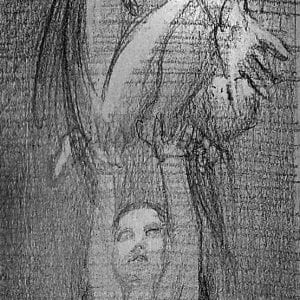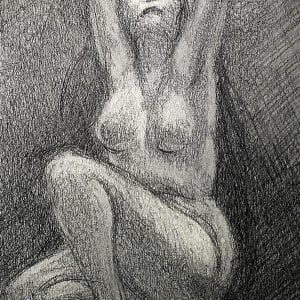Concept Images
Concept #1 – working title “Lift”.
This is an interesting concept to me as well as an interesting composition and ratio for a painting (if this were 24″ wide, it would need to be 8 feet tall – which is monumental). Or, possibly, this could be a sculpture (I’m leaving that open). I’m thinking critically about where added layers of meaning can be inserted within this composition. Currently, it addresses a lot of what I think about when making work – female agency and active rather than passive subject, subject rather than object (avoiding ‘the gaze’ but nakedness might subvert this. Does it reclaim the female figure?), covert indigeneity via the call back to PNW totem poles, and vaguely indigenous looking subjects (more covert indigeneity).
I’m still considering the link between medium and message, aesthetics and ideology. It might be interesting to make this as a sculpture and slightly abstract it. Or it might be interesting to build the foundation from wood and cut the ground to follow the outlines of the subjects with a slight margin – that would push the totemic aspect more and get me away from Western Painting Cannon.
Concept #2 – working title, “Sisters”
Thinking about cumulative narrative, sacredness/religion, and continuing to consider layers of meaning through metaphor and imagery.
The idea of cumulative narrative – the ability to enter into the work at any point is really interesting. I am thinking about the various ways to do this; either a round image or a long, muralistic image.
Sculpture has the virtue of offering entry into its narrative at any point by means of its 3D nature. I’m not thinking about this for sculpture, I like it as it is, but I am thinking about sculpture in context of cumulative narrative.
Concept drawing #3 – Working title, none
Concept #4
Concept #5
Still thinking deeply about medium and message, aesthetics and ideology.
I got my hands on an antique map of Montana – it shows the “Reserve of the Flathead Indians” as encompassing both the Mission valley and the Bitterroot valley and dates to 1881; ten years before the forced removal from the Salish to the Mission valley.
My intention was to take a really abrasive eraser and use it to create an Indian face onto this map, removing the boundary lines of the colonizer and reasserting the face of an indigenous person. The idea that I would be defacing an actual antique was really appealing as was the idea of using an eraser to do it. So much Indian culture has been destroyed and erased. Flipping that script was very satisfying to think about.
But, now that I have the map in hand, I’m not sure I want to deface it. I’m torn and here’s why – On the one hand, I love the idea of erasing an actual antique and all of the connotations that go with that action. On the other, this map is a historic witness to the last years that the Salish were in the Bitterroot and I find that to be a precious thing.
The struggling person suggests survivance, on which I’ve been doing a lot of reading, lately. Gerald Vizenor, who popularized the term, frequently defined “survivance” in opposition to “victimry,”. His work, in his words, “aims to repair a peculiarly vicious consequence of genocidal attacks on natives of the Americas: an inducing in them of their destroyers’ view that they are mere survivors. By accepting this white definition of themselves as victims, natives complete psychologically the not-quite-entirely-successful physical genocide.”
So, in other words, by not accepting the role of victim, indigenous peoples continue to resist accepting the view of themselves that the dominant culture seeks to impose upon them. It is a “condition of self-reliant or communal survival without the social or personal indulgence of victimization.”
For my purposes, I am exploring the term through the lens of contemporary art, which uses it far beyond the context of Vizenor’s own work (although it is often specifically used to speak about Native American art). I find it a good term to situate in as it also speaks to aspects of Du Bois’ dual consciousness, bell hook’s thoughts on intersectionality, and the ways in which the feminine seeks to survive and consider itself in a patriarchal society without resorting to patriarchal labels.
Up to this point in my practice, I’ve been extremely reluctant to use heavily charged symbols in my work. I think this is mostly for two reason. First, such symbols can edge into tope fairly quickly and, second, because the symbols are so heavily charged that they often overshadow other aspects of whatever narrative I’m trying to create. But, in what I think of as a specific James Baldwin-esque response to our current national political climate, I’ve been thinking about the US flag a lot more lately and the juxtaposition between rhetoric and reality.
So I’m thinking about exploring several symbols that I’ve avoided in the past simply to see how I feel about them in my work. I want to be very careful about the semiotics of these explorations. The last thing I want is to appear to support the things that I am trying to speak out against.
Also, as an aside, this is a concept that would be more impactful as a sculpture.
Concept #10 – Untitled (something about consumption, probably).
I tried to get a good likeness of Trump’s mouth but I can’t stand looking at him so this is as good as it got.
Concept #11 – American Flag Ideas
The term “venerated object” as it applies to the US flag. I read up on the Supreme Court decision that allows for use, misuse, and destruction of the US flag to be covered under the First Amendment. The specific decision is Texas v. Johnson, 491 U.S. 397 (1989). The basics of this landmark decision are as follows:
Gregory Lee Johnson burned an American flag outside of the convention center where the 1984 Republican National Convention was being held in Dallas, Texas. Johnson burned the flag to protest the policies of President Ronald Reagan. He was arrested and charged with violating a Texas statute that prevented the desecration of a venerated object, including the American flag, if such action were likely to incite anger in others. A Texas court tried and convicted Johnson. He appealed, arguing that his actions were “symbolic speech” protected by the First Amendment. The Supreme Court heard the case and decided 5-4 in Johnson’s favor.
The majority of the Court, according to Justice William Brennan, agreed with Johnson and held that flag burning constitutes a form of “symbolic speech” that is protected by the First Amendment. The majority noted that freedom of speech protects actions that society may find very offensive, but society’s outrage alone is not justification for suppressing free speech. In particular, the majority noted that the Texas law discriminated upon viewpoint, i.e., although the law punished actions, such as flag burning, that might arouse anger in others, it specifically exempted from prosecution actions that were respectful of venerated objects, e.g., burning and burying a worn-out flag. The majority said that the government could not discriminate in this manner based solely upon viewpoint. The dissent was written by Justice John Stevens, who argued that the flag’s unique status as a symbol of national unity outweighed “symbolic speech” concerns, and thus, the government could lawfully prohibit flag burning.
Here is where I get my knickers in a twist – the term “venerated object” is really problematic. Depending on privilege, it can and often has meant that objects venerated by the privileged are protected while objects venerated by the non-privileged are treated with disrespect openly and often. When I walk into a museum, I see other cultures’ venerated objects everywhere, removed from those cultures (by sometimes questionable or violent means). The word used by museums is “collection”. Which sanitizes these objects for a privileged audience. I find it heartbreaking.
And I suppose that one could argue, since I find it heartbreaking that privileged culture treats these “venerated objects” badly, I should have more empathy for the US flag as a “venerated object”. I wish it were that simple. There are things that I won’t do to this flag I’ve made – I won’t urinate or defecate on it. I won’t use it to malign troops, either former or active. And I won’t write vulgarities on it. But using it as a means to call attention to privilege and systems of oppression? Yes. I will do that. And as the current symbol of a Nationalist cult that wants to strip rights – hard fought rights – from vulnerable individuals in our society, I will use it and anything else I can to bring attention to those issues. Because, often, a privileged group won’t listen until it’s pushed to do so. Honestly, if we are to call ourselves patriots in the true sense of the word, we should all be angry that white supremacists and nationalists are co-opting the US flag for such purposes. If it is truly the symbol of freedom and equality, those groups using it is a perversion of epic proportions.
As I’ve continued to research the US flag, I’ve had several ideas come to me about how I want to use it as a very loud, emotionally charged symbol. I’ll first need to finish this one, though. I need to teach my embroidery machine to make stars of the right size and then I’ll need to sit there and embroider them. Also, did you know that there was a specification for the size and shape of the various elements of the flag? I wanted to make a flag on spec because I wanted to start with a “perfect” flag but I screwed that up so I’m going to have to make another one. This one will still get finished but, for purposes of using it as a painting reference, it’s fine.
Which brings me to the last thing I want to talk about – I made this flag. I tore the strips, I sewed the lapped seams, I will machine embroider the stars. Is this flag now more mine to do with as I please than any flag I might purchase? John Locke would say “yes”. His Labor Theory of Property is known as a theory of ‘natural law’. It holds that property originally comes about by the exertion of labor upon natural resources. The theory has been used to justify the homestead principle, which holds that one may gain whole permanent ownership of an unowned natural resource by performing an act of original appropriation.
And how interesting is the use of that last word, right? In fact, how interesting is that entire theory when seen through Indian eyes?
Back to asking myself what my intentions are with my work. Which means that I am back to thinking about monumentalism and why I feel compelled to make small things in a monumental size. Which, I think, comes from a wish to show often overlooked things in a format which makes it impossible to overlook or ignore them.
This would be an interesting large painting especially if I could find really hi-res photos of bees.
(US Geological Survey Bee Inventory and Monitoring Laboratory – hi res, public domain photos of various bee species).
.
.
Concept #13 – Mask
Concept #14 – Hands, v.1
Concepts #15 & #16 – Paper embossing covered in graphite, based on the happy accident present in #14.
Concept #17 – Hands, v. 2
Flipping the hands to palm out and changing the number to seven (seven generations).
Study #1: Aunt Margaret
Study #2: Zitkala-Sa
Concept #18: Crow POV
Concept #19: Hands
Concept #20: Seraphim
Concept #21: The Treachery of Words: Ce n’est pas un Indien d’Amérique













































